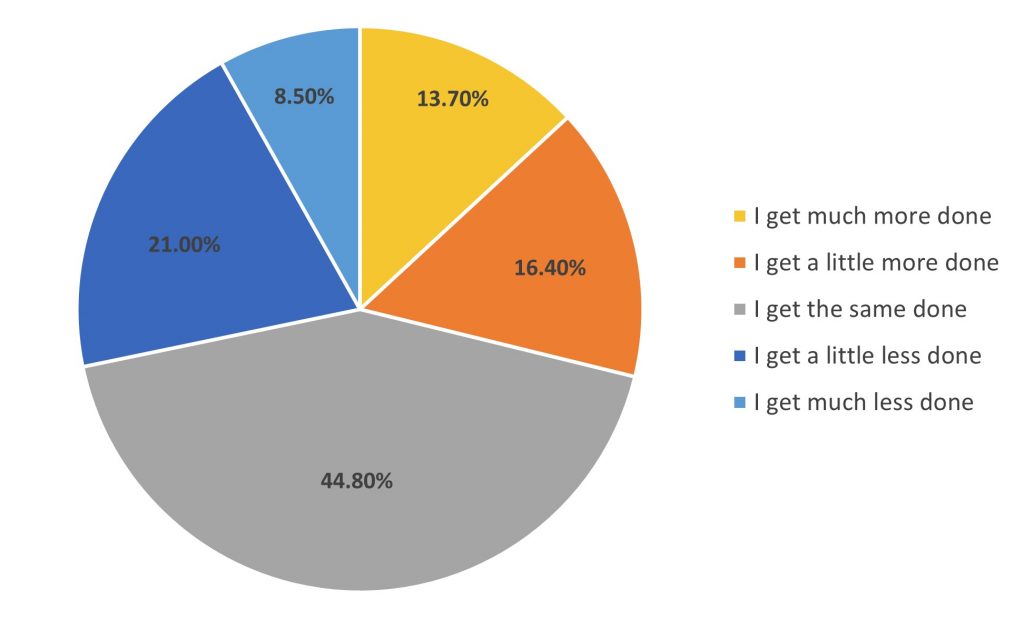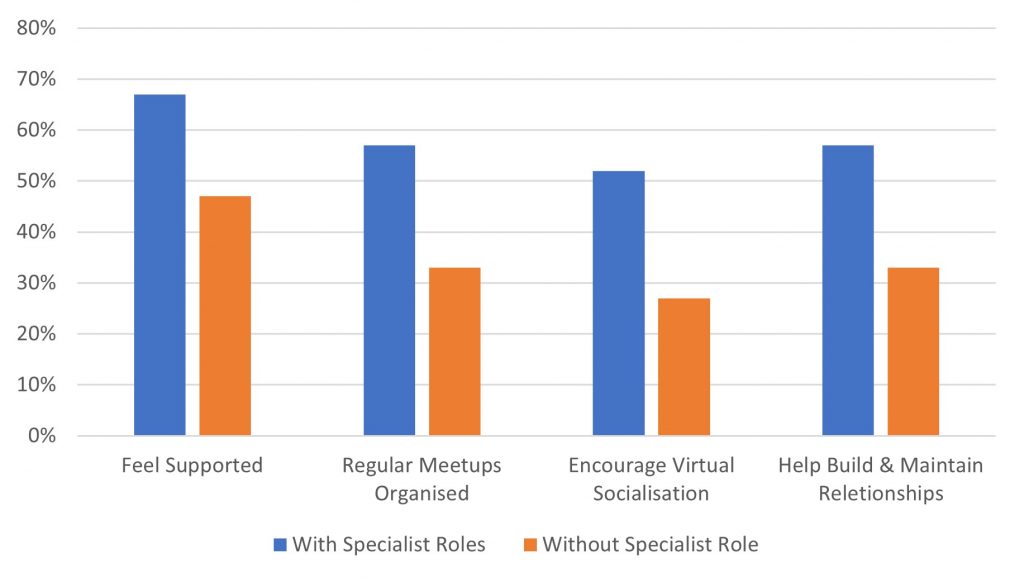
During the COVID-19 pandemic, UK organisations were forced to swiftly shift their operations away from offices and into homes, leading to one of the biggest social experiments in history.
14 months and a vaccine later, UK businesses are now at a crossroads as to what the future of working will look like. The initial disruption and mayhem of the early days has moved towards a more considered and insightful approach to managing remote work. 9 out of 10 businesses say they have adapted to hybrid working, however with the possibility of fully returning to offices on the horizon, firms will soon be held to a higher standard in how they operate and for the wellbeing of their staff.
This post will look at the challenges and opportunities created by hybrid working for both employees and employers, tackling 4 main issues:
– Increase in stress from remote working
– Lack of meaningful socialising and connection with colleagues
– How to attract and maintain the top hybrid working talent
– What to do with existing assets and office spaces
Employees
By removing the need to commute and allowing workers to be more flexible with their day, 56% of employees reported an increase in their happiness levels when they work from home. Consequently, 9/10 employees who worked at home during the lockdown would like to continue working at home in some capacity (88.2%). If the majority of a workforce is happier working from home, this creates a new mandate for employers to build an effective hybrid workplace that works for everyone.
However, the benefits of a more homely and convenient work environment are weighed down by two key factors:
– Increase in stress from work
– Lack of meaningful socialising and connection with colleagues
Increase in Stress from Work
The positive impact on happiness caused by being based at home comes at the cost of visibility – meaning staff feel they need to show their worth by putting in a longer shift. Almost one in three (30%) report an increase in their hours whilst working from home, and more than half (53%) agree they feel they have to be available at all times, leading to employees taking fewer breaks (52%). This increase in work stress suggests a lack of understanding between employee mentalities and employer demands.
Whilst productivity is a fundamental measure of employees, hybrid working performance cannot be measured with the exact same parameters as office working. Therefore, organisations must create new policies in order to establish the performance markers and best practices for homeworking.
Once policies have been formed, consistent communication is key to increase employee visibility and reinforce best practices. A well-established timetable of communication allows employees to plan their schedules better and not feel tied to their laptops. Consequently, home workers can take guilt-free breaks and tailor their hours to best suit them.
At this stage there may be a need for some refresher training for managers about how they approach performance management to judge the performance of employees. It needs to be done on a much more regular basis as people who have been working from home will not have had as much interaction with their manager as they might have done in the office. We need to remove our own biases when reviewing people’s performance, as people’s performance will be fundamentally different right now compared to last year. As a result, we will have to think quite differently in our judgement mechanisms. – Director at Sony UK Technology Centre
Lack of meaningful socialising and connection with colleagues
A majority of employees (60%) report that they feel less connected to their team and colleagues whilst working from home. When it is safe to return to the office, 62% have said they would like to go into the office again to work with colleagues, with a third doing it to socialise with colleagues (32%).
Whilst many organisations initially set up time for employees to socialise online, only 39% of people surveyed said their employer organised regular online meet-ups when working from home. After an early boom in online events, many people suffered fatigue caused by numerous virtual family quizzes alongside virtual staff meetings, causing a drop off in online meet-up attendance.
The data shows that the majority of employees are discontent with a purely virtual social life and consequently, they desire to return to offices in order to see people face to face. This could lead to a change in the function of office spaces, with communal spaces becoming more valuable. The informal meetings that take place within an office have been lost due to homeworking, causing difficulty for newer staff to meet anyone outside their own department.
“The organisation is almost operating within two slightly different cultures: one which the older staff members are already used to, and one where newer staff members have not had a chance to mingle with the broader organisation. We have lost that informality where you might just walk into the office and meet and speak with a colleague from any department” – CEO of Major Charity
If offices were to become the hub for all employee socialisation, then businesses run the risk of alienating any staff who choose to work predominantly from home. Firms must strike a balance in providing opportunities for connection, both virtually and physically so that employees can build lasting friendships. A greater sense of belonging leads to higher employee satisfaction and therefore, a lower job turnover rate.
Employers
When homeworking began, employers were fearful that without physical oversight, employee productivity would fall. However, data suggests that the UK lockdowns had little effect on productivity either way.

Of those who said that their productivity had fallen, 30% said it was due to simply having less work to do, whilst a further 28% said it was down to home-schooling their children. In both cases, the reasoning was closely linked with the UK lockdown restrictions rather than homeworking itself.
With employee output remaining consistent, businesses have no excuse for embracing different ways of working. If they do not offer the same level of flexibility, they will be left behind their competitors and will no longer be able to compete for talent. Firms have to be prepared to accept that the best talent is not always on their doorstep – or willing to move.
There are two main considerations for employers to consider as they build the foundations for hybrid working in their businesses:
– How to attract and maintain the top hybrid working talent?
– What to do with existing assets and office spaces?
How to attract and maintain the top hybrid working talent?
With the initial frantic transition to home working in March 2020, many employees realised they did not have a suitable home office set-up. Consequently, over half of employees (55%) said they had to invest their own time or money to create an effective home working environment. This has sparked a change in how people view employee benefits with increasing interest in perks that make remote working more comfortable and efficient.
When asked for the top benefits employees would choose to support their remote working environment:
– 56% chose a bonus to invest in their home office however they see fit
– 51% picked high-speed broadband
– 48% wanted new office furniture
To address these evolving employee expectations, some firms have created new roles and responsibilities for managers to help their organisations adapt to the hybrid environment. The survey findings show that in organisations that have introduced new roles to oversee remote working, more employees felt supported during this time (67% compared to 47% for those without new roles). These employees agree that their employer organises regular virtual social meetups (57% compared to 33%) and encourage their staff to take time out of work to virtually socialise (52% compared to 27%) and build and maintain relationships (57% compared to 33%).

As well as providing the resources to adjust to the business and to working from home, businesses also need to provide opportunities to develop skills and progress. Previous CIPD (Chartered Institute of Personnel and Development) research has shown that employees working flexibly are more likely to suffer negative career implications. Therefore, employers need to utilise digital learning technology to allow people who are working remotely to build the skills they need to develop.
What to do with existing assets and office spaces?
With the demand for office space in decline, many businesses will be going through the process of reducing their property portfolio, as well as optimising their existing office spaces. Therefore, change is coming to all areas of the business, not just for remote working.
Comprehensive assessments need to be undertaken in order to understand which assets will be needed moving forward. This will help identify if sites need to be closed, reduced or transformed for new purposes.
Once assets have been assessed, management and business leads will need to agree on what transformations are needed to accommodate a varied workforce. Previously, it was commonplace for each department to have their own space/floor and departments would only mix in the canteen or break room. However, with collaboration moving online, there is no need for such rigid boundaries between staff. Employees will be able to mingle with a wider variety of staff as they are given greater flexibility in where they work and with whom they interact with. Conference rooms can become hubs for team or project collaborations and even receptions and canteens can be reworked for greater utilisation.
This change also brings the possibility of decentralising offices for greater choice and flexibility in where to work. Instead of a large office block in central London, businesses can instead invest their money into smaller, more widespread working spaces all over the UK. This approach provides a middle ground between working from home and working in an office, shortening commutes and providing much greater flexibility for employees.
If businesses are keen to return to previous office working habits, improvements will have to be made in order to attract the employees who currently would prefer remote working. Firms will have to provide a safe working environment that can raise productivity and creativity, whist also providing employees with a feelgood factor.
In order to stay competitive and provide great employee satisfaction, employers need to consider all their options as they dictate how their business is going to adapt to the modern working environment. There is no one-size-fits-all solution and as such, these decisions should not be taken lightly or without the input from all the stakeholders involved.
Sources:
Felstead, A and Reuschke, D (2020) ‘Homeworking in the UK: before and during the 2020 lockdown’, WISERD Report, Cardiff: Wales Institute of Social and Economic Research.
Work Smarter to live Better – Microsoft & CIPD (Work Smarter to Live Better (microsoft.com)
As change experts, it is our job to provide the knowledge and experience of how to transition smoothly and successfully, even in these unprecedented circumstances. PDCS ensures you have the right people and resources so that you can be at the forefront of this industry-wide change, allowing you to adapt to the new way of working and remain competitive in the short and long term future.

